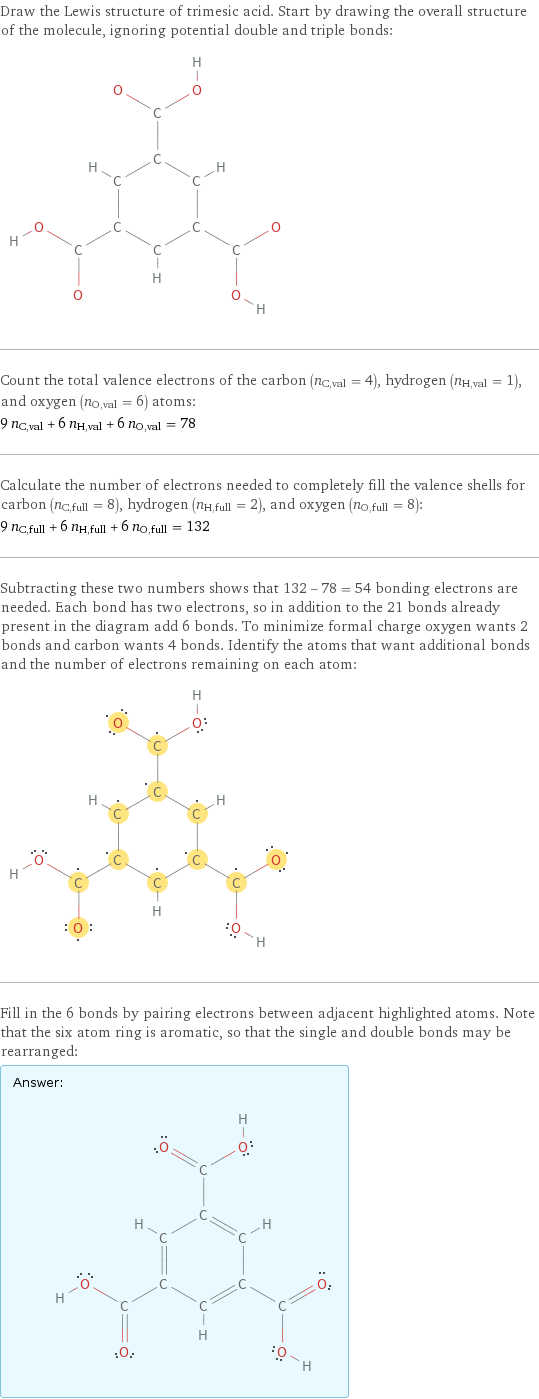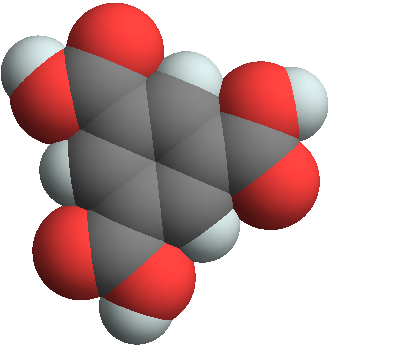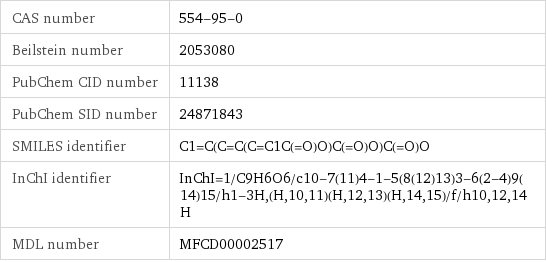Input interpretation

trimesic acid
Chemical names and formulas

formula | C_6H_3(CO_2H)_3 Hill formula | C_9H_6O_6 name | trimesic acid IUPAC name | benzene-1, 3, 5-tricarboxylic acid alternate names | 1, 3, 5-benzenetricarboxylic acid | 5-carboxyisophthalic acid | benzene-1, 3, 5-tricarboxylic acid | trimesinic acid | trimesitinic acid mass fractions | C (carbon) 51.4% | H (hydrogen) 2.88% | O (oxygen) 45.7%
Lewis structure

Draw the Lewis structure of trimesic acid. Start by drawing the overall structure of the molecule, ignoring potential double and triple bonds: Count the total valence electrons of the carbon (n_C, val = 4), hydrogen (n_H, val = 1), and oxygen (n_O, val = 6) atoms: 9 n_C, val + 6 n_H, val + 6 n_O, val = 78 Calculate the number of electrons needed to completely fill the valence shells for carbon (n_C, full = 8), hydrogen (n_H, full = 2), and oxygen (n_O, full = 8): 9 n_C, full + 6 n_H, full + 6 n_O, full = 132 Subtracting these two numbers shows that 132 - 78 = 54 bonding electrons are needed. Each bond has two electrons, so in addition to the 21 bonds already present in the diagram add 6 bonds. To minimize formal charge oxygen wants 2 bonds and carbon wants 4 bonds. Identify the atoms that want additional bonds and the number of electrons remaining on each atom: Fill in the 6 bonds by pairing electrons between adjacent highlighted atoms. Note that the six atom ring is aromatic, so that the single and double bonds may be rearranged: Answer: | |
3D structure

3D structure
Basic properties

molar mass | 210.14 g/mol phase | solid (at STP) melting point | 300 °C solubility in water | very soluble
Units

Solid properties (at STP)

vapor pressure | 2×10^-13 mmHg (at 25 °C)
Units

Thermodynamic properties

molar heat of combustion | 3214 kJ/mol specific heat of combustion | 15.29 kJ/g (at STP)
Chemical identifiers

CAS number | 554-95-0 Beilstein number | 2053080 PubChem CID number | 11138 PubChem SID number | 24871843 SMILES identifier | C1=C(C=C(C=C1C(=O)O)C(=O)O)C(=O)O InChI identifier | InChI=1/C9H6O6/c10-7(11)4-1-5(8(12)13)3-6(2-4)9(14)15/h1-3H, (H, 10, 11)(H, 12, 13)(H, 14, 15)/f/h10, 12, 14H MDL number | MFCD00002517
Safety properties

autoignition point | 590 °C